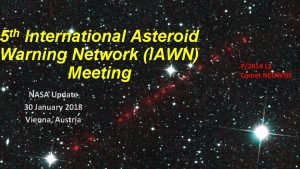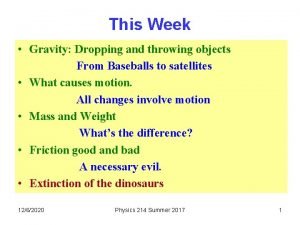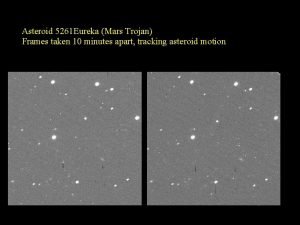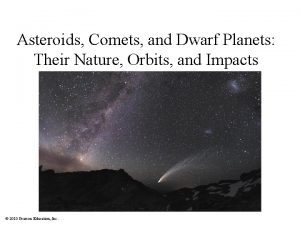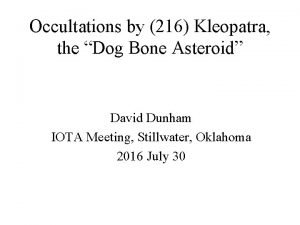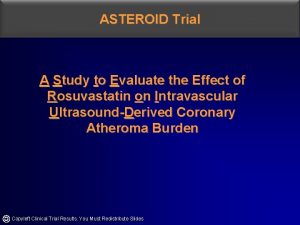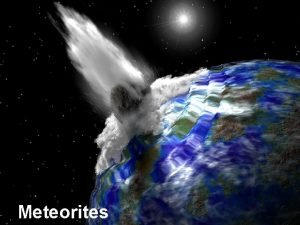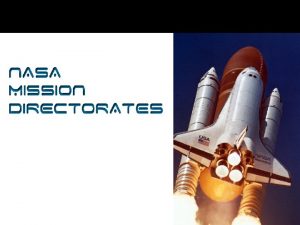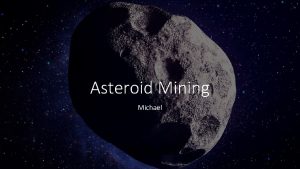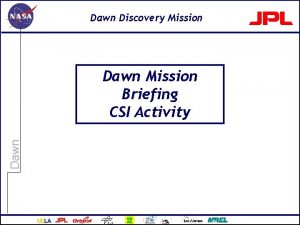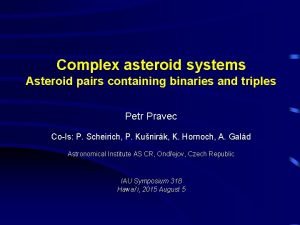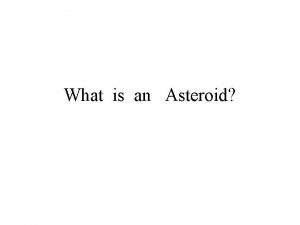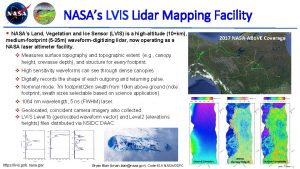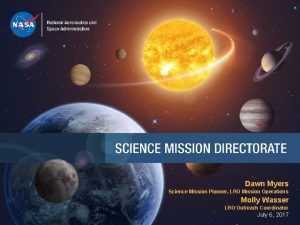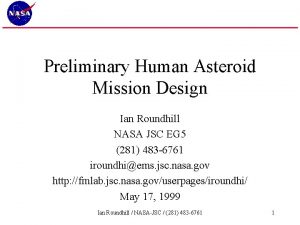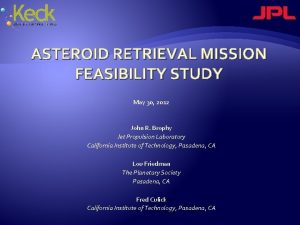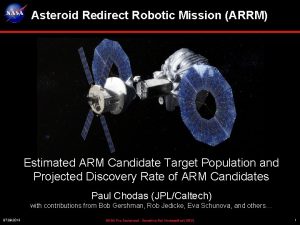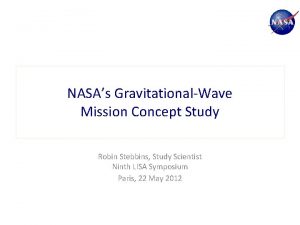Dawn NASAs Dawn Mission Journey to the Asteroid





































- Slides: 37

Dawn NASA’s Dawn Mission Journey to the Asteroid Frontier 1 Lucy Mc. Fadden, Co-Investigator University of Maryland College Park, MD July 18, 2007 Night Sky Network

Dawn The Dawn Mission 2 9 th mission in NASA’s Discovery Program http: //discovery. nasa. gov

Dawn Traveling Back In Time 3

Dawn Explores the Earliest Epochs Dawn Vesta and Ceres are intact survivors of the earliest epoch of planetary formation. 4

Dawn The Asteroid Belt 5

Spacecraft Dawn Dry mass: 745 kg Wet mass: 1240 kg Solar array power (1 AU): 10. 3 k. W Solar array power (3 AU): 1. 3 k. W Delta II 7925 H-9. 5 6

Dawn Interplanetary Trajectory 7

Dawn Ion Propulsion Deep Space 1 8

Ion Propulsion System 2. 3 meters Hydrazine tank Dawn 45 kg capacity 9 Xenon tank 450 kg capacity Ion thruster Folded solar arrays

Dawn Instruments 10 HGA – High Gain Antenna LGA – Low Gain Antenna CSS – Coarse Sun Sensors GRa. ND – Gamma Ray and Neutron Detector IPS Thrusters – Ion Propulsion Thrusters RCS Thrusters – Reaction Control System Thrusters VIR – Visual and Infrared Spectrometers FC – Framing Camera

Dawn Map the Gravity Field Vesta Gravity from Shape Model 11

Framing Camera Supports: Imaging Science Navigation Topography Gravity Science These functions are mission critical Dawn Two identical units to fly for 100% redundancy 12 § § § § 1024 x 1024 pixels frame-transfer CCD 14 µm pixel size F/8 system 5. 5° x 5. 5° Fo. V 93 µrad i. Fo. V (1 pixel) 7 filters + clear channel FC current design (left) FC EM (below)

Mapping Global Topographic Maps Dawn Framing Camera techniques have been proven on many previous missions. The camera’s most recent heritage comes from Venus Express. 13

Mapping Spectrometer: VIR Dawn VIR experiment is a compact imaging spectrometer housing two data channels in the same optical head. It is made of 2 modules • Optical head • Electronics box 14 VIR will allow to perform spectroscopic measurements of the Vesta and Ceres surface in the range 0. 35 -5. 01 um were most signatures of rock-forming minerals are present

GRa. ND Cutaway view of GRa. ND Features Dawn § Neutron spectroscopy using Li-loaded glass and boron-loaded plastic phoswich § Gamma ray spectroscopy using Bismuth Germanate and Cadmium Zinc Telluride (new technology) § Design enables measurement and suppression of background from the space environment 15 Operating modes § Standby § Operating § Anneal 18. 0 cm 25. 7 cm

Map the Elemental Composition Dawn Gamma ray and neutron detector (GRa. ND) techniques have been proven on Lunar Prospector. GRa. ND’s most recent heritage is from Mars Odyssey 16

Exploring New Worlds Dawn’s Itinerary: Launch September, 2007 The Dawn Spacecraft will travel • 6. 3 billion kilometers (almost 4 billion miles) Dawn • In eight years 17 • To the asteroids, 4 Vesta and 1 Ceres.

Dawn Partners 18 – University of California, Los Angeles • Scientific Leadership – JPL – Jet Propulsion Laboratory • Management and Navigation – Orbital Sciences Corporation • Spacecraft design and build – Los Alamos National Laboratory • GRAND instrument – DLR – German Aerospace Center • Framing Camera – Max Planck Institute for Solar System Research • Framing Camera – ASI – Italian Space Agency • VIR – New Roads School, University of Maryland, and Mc. REL • Education and Public Outreach

Mission Timeline Baseline mission shown in green Minimum mission shown in blue Mars gravity assist Dawn Mar ‘ 09 (4) Vesta arrival Oct ‘ 11 (4) Vesta departure (1) Ceres arrival End of mission May ‘ 12 Aug ‘ 15 (4) Vesta departure (1) Ceres arrival Feb ‘ 12 Sep ‘ 15 Jan ‘ 16 Launch Jun ‘ 07 Note: There is a continuum of options between the baseline and minimum, varying in scientific return, cost, and technical robustness. 19

Background of Ceres First asteroid discovered in 1801 Biggest asteroid with a diameter about 1000 km a=2. 77 AU, e=0. 079, i=10. 6 �� Probably hydrated (Lebofsky 1981, Feierberg 1981) or ammoniated (King et al. 1992) Dawn Target of Dawn, scheduled to orbit Ceres in 2015 for 11 months 20

Dawn 2007 Vesta apparition • 21 Vesta last made such a close approach to Earth in June, 1989.

Dawn Hubble Space Telescope 22

Vesta in May 2007 Wide Field Planetary Camera 2 (WFPC 2) • Four Filters: F 439 W, F 673 N, F 953 N, F 1042 M – Same filters as previous observations in 1994, 1996. • Preliminary image deconvolution – Maximum Entropy Method (MEM) • Color composite images: F 439 W+F 673 N Dawn • 23

Dawn Hubble WFPC 2 F 439 W image of asteroid Vesta in May 2007: raw 24

Dawn Hubble WFPC 2 F 439 W Vesta in May 2007: deconvolved (MEM) 25

Dawn Hubble WFPC 2 F 439 W images of asteroid Vesta in May 2007: raw 26

Dawn Hubble WFPC 2 F 439 W Vesta in May 2007: deconvolved (MEM) 27

Dawn Hubble WFPC 2 Vesta May 2007 Color Composite To watch the Rotation of Vesta, click here: http: //hubblesite. org/newscenter/archive/releases/2007/27/video/a/ 28

Dawn 500 km 29 500 km

Ceres observations 2003 -2004 Dawn • • • 30 Map Ceres through one complete rotation in multiple filters. Improve knowledge of its size, shape and pole orientation. Search for satellites Extend knowledge Apply to sequence planning for Dawn

Dawn Ceres 2003, 2004 31

Hubble images of Ceres in January 2004 Dawn • • • 32 Advanced Camera for Surveys (ACS) High Resolution Channel (HRC) Filters: F 220 W, F 330 W, F 555 W Sub-sampled (dithered) images were drizzled to enhance resolution Color composite images: F 330 W+F 555 W Movies made from lower-resolution images (full phase coverage)

Dawn Hubble images of Ceres reveal roundness, surface features, and colors Three different faces of Ceres 33

Dawn Ceres’ Rotation To see the video of Ceres’ rotation, go to: 34 http: //hubblesite. org/newscenter/archive/releases/2005/27/video/b/

35 Dawn

Learn More! Dawn http: //dawn. jpl. nasa. gov 36

Unlocking the Mysteries Dawn Science on the Edge of Our Solar System 37 33
 Asteroid belt
Asteroid belt International asteroid warning network
International asteroid warning network Where can we mostly asteroid found
Where can we mostly asteroid found Asteroid impact simulation
Asteroid impact simulation 5261 eureka
5261 eureka Asteroid belt origin
Asteroid belt origin Mikayahl
Mikayahl Eve serpentis narcotics warehouse
Eve serpentis narcotics warehouse Asteroid trial
Asteroid trial Type of meteorites
Type of meteorites Scintillate scintillate asteroid minific
Scintillate scintillate asteroid minific độ dài liên kết
độ dài liên kết Các môn thể thao bắt đầu bằng tiếng chạy
Các môn thể thao bắt đầu bằng tiếng chạy Sự nuôi và dạy con của hổ
Sự nuôi và dạy con của hổ điện thế nghỉ
điện thế nghỉ Một số thể thơ truyền thống
Một số thể thơ truyền thống Nguyên nhân của sự mỏi cơ sinh 8
Nguyên nhân của sự mỏi cơ sinh 8 Trời xanh đây là của chúng ta thể thơ
Trời xanh đây là của chúng ta thể thơ Chó sói
Chó sói Các số nguyên tố
Các số nguyên tố Thiếu nhi thế giới liên hoan
Thiếu nhi thế giới liên hoan Tỉ lệ cơ thể trẻ em
Tỉ lệ cơ thể trẻ em Tia chieu sa te
Tia chieu sa te Các châu lục và đại dương trên thế giới
Các châu lục và đại dương trên thế giới Thế nào là hệ số cao nhất
Thế nào là hệ số cao nhất Hệ hô hấp
Hệ hô hấp Tư thế ngồi viết
Tư thế ngồi viết Hát kết hợp bộ gõ cơ thể
Hát kết hợp bộ gõ cơ thể đặc điểm cơ thể của người tối cổ
đặc điểm cơ thể của người tối cổ Cách giải mật thư tọa độ
Cách giải mật thư tọa độ Chụp phim tư thế worms-breton
Chụp phim tư thế worms-breton Tư thế ngồi viết
Tư thế ngồi viết ưu thế lai là gì
ưu thế lai là gì Thẻ vin
Thẻ vin Cái miệng xinh xinh thế chỉ nói điều hay thôi
Cái miệng xinh xinh thế chỉ nói điều hay thôi Thể thơ truyền thống
Thể thơ truyền thống Các châu lục và đại dương trên thế giới
Các châu lục và đại dương trên thế giới Từ ngữ thể hiện lòng nhân hậu
Từ ngữ thể hiện lòng nhân hậu

